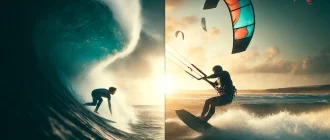Is kiteboarding dangerous? This exciting sport combines the exhilaration of surfing with the aerial possibilities of paragliding, but it also poses certain risks. This article examines the safety concerns associated with kitesurfing, from equipment malfunctions to challenging weather conditions.
We’ll discuss practical safety measures for kiting and compare its risk profile to other sports, equipping you with the knowledge to kiteboard with confidence.
Main Points
- Kiteboarding is exhilarating but comes with inherent risks, including equipment failure, challenging weather conditions, and a range of common injuries, from minor to severe.
- Adopting rigorous security measures, such as proper equipment maintenance, mastering kite control, and informed spot selection based on weather conditions, can mitigate the dangers of kitesurfing.
- Experience and proper training play crucial roles in safety, helping kiteboarders evaluate their skills and navigate safely, while psychological factors such as overconfidence and complacency can introduce additional risks.
Understanding the Risks of Kiteboarding

Kiteboarding brings a unique blend of excitement and danger. While enthusiasts are often drawn to the sport by the allure of the unexpected, a comprehensive understanding of the risks is vital for a safe and enjoyable experience.
Experience level and wind conditions are two significant factors that contribute to the risks associated with kiteboarding. Despite advancements in kitesurfing equipment and protection gear, the injury rate has not decreased considerably, underscoring the importance of recognizing potentially dangerous situations, even for seasoned kiteboarders.
Riding isn’t the only source of danger in kiteboarding. Equipment considerations and potential failures, navigation through varying weather and wind conditions, and the possibility of common kiteboarding injuries all contribute to the inherent risks of this sport. All these factors significantly impact the risk assessment in kitesurf.
Equipment Considerations and Potential Failures
The fun and safety of kitesurfing depend heavily on the integrity of the equipment used. Line breaks and quick-release malfunctions are among the most common equipment failures in kiteboarding, significantly increasing the risk of accidents. The harsh marine environment and waves can cause kite lines to rust and canopies to deteriorate, while using outdated equipment may lack advanced protection features.
Hence, stringent maintenance, such as inspecting lines, harnesses, and connections for damage, along with timely replacement or repair of any compromised parts, is critical for ensuring kitesurfing safety.
Rigorous equipment checks for signs of wear or failure, along with well-planned emergency action, can effectively mitigate the risks associated with equipment failure.
Navigating Weather and Wind Conditions
A fundamental aspect of kitesurfing is understanding the wind window. It dictates where the kite can fly and generate power, with incorrect positioning outside the wind window, causing the kite to stall and fall. The size of the wind window, determined by the length of the kite’s lines, directly affects the kite’s power generation and safety.
Monitoring wind conditions, which influence power and speed, is vital for kitesurfing. Gusts and strong wind are significant factors in wind forecasts. Sudden increases in wind speed present potential hazards and should be cautiously approached by kiteboarders.
Launching and landing a kite safely involves moving it through the air in the low power zone to prevent being pulled off balance. Keeping the drop and catch zone clear of obstacles is crucial for safety, preventing gear damage, and reducing accident risks during kite handling.
Recognizing Common Kiteboarding Injuries
Injuries in kitesurfing can range from minor issues like cuts and bruises to more severe concerns, including the most common injuries, such as:
- broken bones
- spinal cord injuries
- head injuries
- dislocations
- sprains and strains
Severe cases can potentially even lead to death. The foot and ankle are particularly vulnerable to injuries in kitesurfing, often due to landing forces and the tight positioning of the foot in straps during maneuvers.
Kiteboarding injuries can include:
- Knee sprains or fractures from being thrown from the board or incorrect landings
- Joint injuries from impact or twisting motions
- Overuse injuries such as back, neck, forearm, and shoulder pain
- Severe injuries like fractures and ligament tears
While the majority of kitesurf injuries are relatively mild, it is essential to take precautions and seek medical attention for any severe or persistent pain, especially in the early days in case of a kitesurfing accident.
Safety Measures Every Kiteboarder Should Adopt
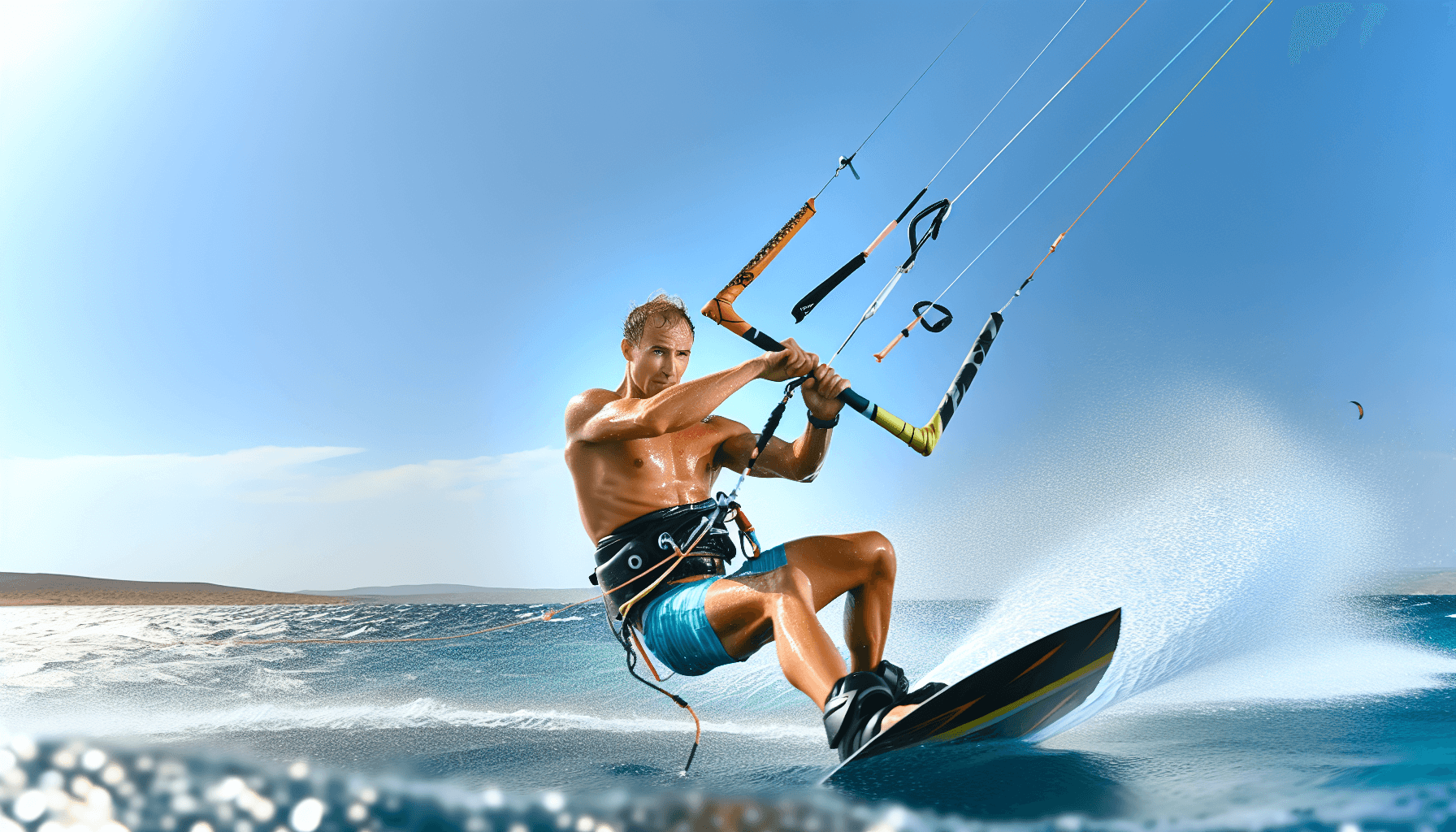
Navigating the risks in kitesurfing involves understanding what could go wrong and taking proactive measures to prevent these risks. Adopting safety measures can significantly reduce the dangers inherent in kitesurf.
Proper training ensures a rider can respond correctly and quickly under various circumstances. Enhanced understanding of injury mechanisms and developing good kitesurfing techniques can significantly minimize the risk of accidents and serious injuries.
Using a quick-release system, wearing a helmet, and wearing a protective vest are essential yet vital tips for minimizing dangers in kiteboarding. A flotation aid is critical to keep a kiteboarder afloat in situations such as being knocked unconscious or losing the ability to swim.
Kiteboarders should practice neither too far nor too close to the coast and avoid kiteboarding in stormy weather conditions. With the right conditions, training, and safety gear, kitesurfing can be safe and fun for beginners.
The Role of Safety Gear in Preventing Serious Injuries
The risk of severe head and torso injuries in a kiteboarding accident is significantly reduced by wearing a helmet and an impact vest. It’s crucial for experienced kiteboarders to regularly review their crash and practice operating their protection gear to prevent complacency and ensure preparedness for potential accidents.
A vital aspect of a kiteboarder’s protection equipment is glasses or goggles with UV protection, which is crucial for protecting the eyes from the sun and water reflections.
Mastering Kite Control for Safer Rides
A foundational kite control skill, which aids riders in maintaining balance and control over the kite’s position in the wind window, involves:
- Steering the kite with one hand
- Carving small S-turns
- Practicing sending the kite up and down with wrist movements and pressure on different parts of the bar
This helps develop precise kite control, which is crucial for safe kiteboarding.
Mastering edge control in kitesurfing is vital for efficient maneuvers like jumping and upwind riding. Here are some key points to remember:
- Edge control impacts the kite’s power and position.
- Gaining familiarity with the kite’s response to edging and board control allows kiteboarders to manage the kite’s power and position more effectively.
- Edge control influences speed and maneuverability.
By practicing and improving your edge control, you can perform advanced maneuvers and have more control over your kitesurfing experience.
Staying Informed: Wind Forecast and Spot Selection
For kitesurfing protection, especially for beginners who need suitable wind conditions to minimize accidents and injuries, checking wind forecasts and weather forecast is crucial. To comprehensively understand expected wind patterns, kiteboarders should cross-reference data from multiple wind forecast websites.
The selection of a kitesurfing spot is influenced by the wind’s direction and strength and the location’s busyness, affecting the security and enjoyment of the ride. Local kitesurfing shops offer valuable insights into spot selection and gear advice suitable for the current weather conditions, helping to protect and reduce the risk of accidents.
The Impact of Experience on Kiteboarding Safety
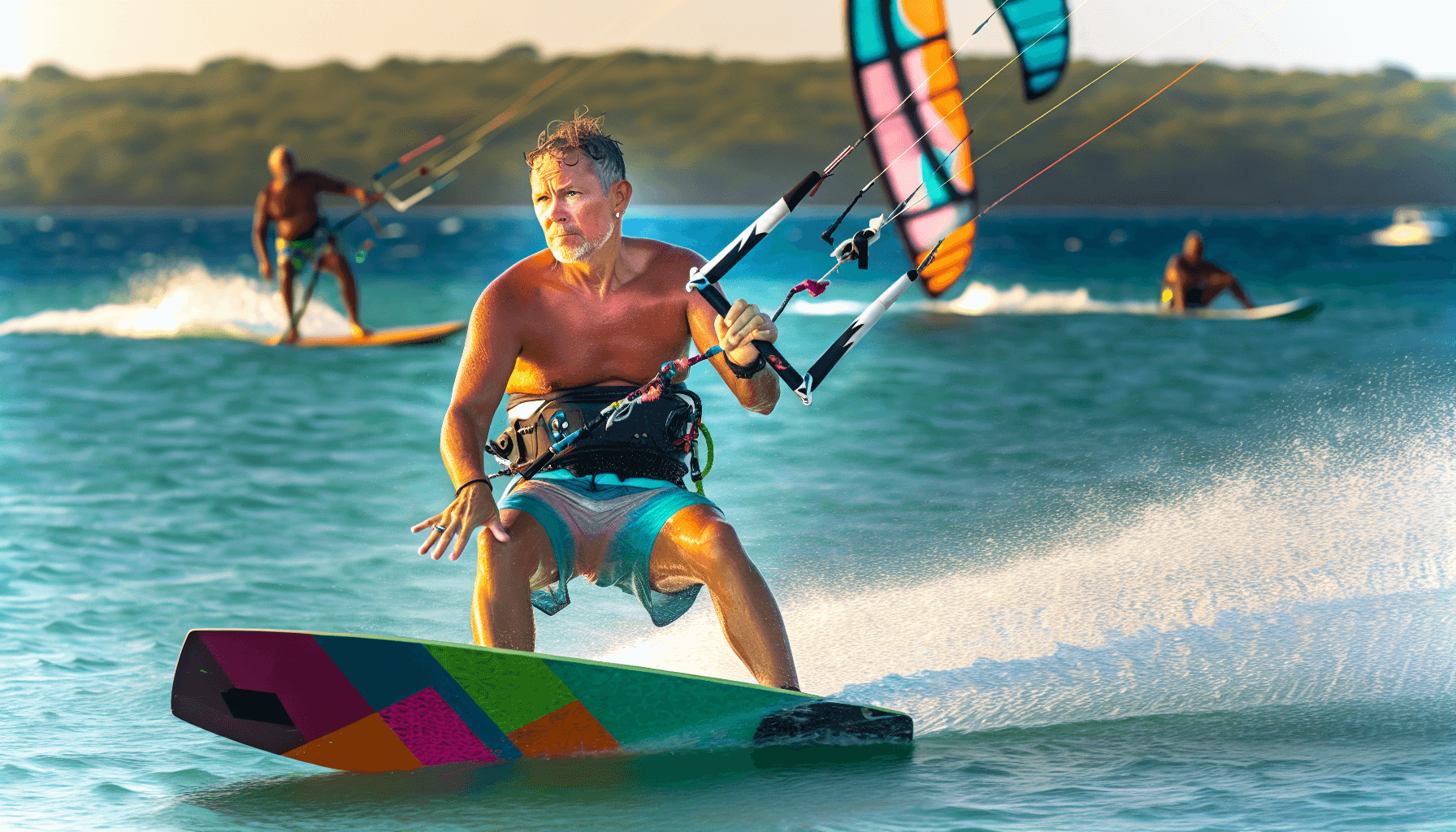
Experience plays an undeniable role in kitesurfing protection. A significant reduction in the risk of kitesurfing injuries can be achieved by understanding and maintaining awareness of one’s skill level.
To avoid accidents, kiteboarders must carefully evaluate their skills in conjunction with the specific conditions at a kitesurfing location.
Selecting a kitesurfing school entails careful consideration, focusing on the following factors:
- The instructor’s environmental knowledge
- The teaching methodology used
- Suitable gear
- Protection devices
- Liability and accident insurance
- Emergency plans
A reliable kitesurfing school should meet these criteria.
From Novice to Pro: The Learning Path
Mastering basic skills, intermediate techniques, and advanced maneuvers marks the progression from a novice to a pro in kiteboarding.
Beginners in kitesurfing should start with a trainer kite on the beach or in a park to learn basic kite handling skills. After completing basic instruction, a novice kiteboarder needs to practice persistently to master staying upwind and riding while kitesurfing without an instructor.
Once basic kitesurfing is mastered, intermediate skills involve mastering toeside riding, executing bigger jumps, and learning maneuvers such as slalom turns, download turns, beach starts, and kite loops on the water.
For higher jumps, kiteboarders should practice setting the kite deeper into the wind window to gain power and speed, then redirecting the kite forward for controlled landings.
When to Ride: Understanding Safe Wind and Weather Conditions
Understanding safe wind and weather conditions is instrumental in ensuring a safe kiteboarding experience. Kiteboarders should select the appropriate kite and board size based on their skill level, body weight, and the available wind conditions. For their protection, beginners should avoid kitesurfing in solid and offshore winds.
While professional riders can kiteboard in less than ten mph winds with specialized gear and skills, it’s not recommended for those with less expertise. Side-onshore winds, which blow the air from the sea towards the shore at an angle, are ideal for enabling beginners to return safely to the beach.
Cross-onshore winds are recognized as the best wind direction, minimizing the risks of accidents and aiding in decision-making.
Beginners should look for winds in the range of 11 to 13 knots, considered safe and manageable for learning.
Riding Etiquette: Sharing the Water Safely
To prevent accidents and injuries, practicing safe riding etiquette is paramount. The kiteboarder entering the water has the right of way over incoming riders, allowing for safe transitions between the beach and the water.
When two kiteboarders approach each other, the rider on the other kiter’s right (starboard) side has priority, helping prevent head-on collisions.
Kiteboarding etiquette includes the following guidelines:
- A faster kiteboarder must yield to a slower rider in front to avoid creating dangerous situations from behind.
- The rider actively surfing a wave holds priority over others, ensuring clear passage and minimizing interference.
- Keeping a safe distance from other kiters and water users is essential to prevent injury-causing collisions.
- To avoid interference and dangerous encounters, kiteboarders must yield to other ocean and beach users traveling downwind.
Comparing Kiteboarding to Other Sports

Despite popular belief, the injury rate for kiteboarding—10.5 injuries per 1000 hours—is on par with other popular contact sports like motocross, soccer, and American football. Kiteboarding does not have a disproportionately high injury rate compared to other popular sports.
Contrary to common belief, kiteboarding is not more extreme than other high-risk sports and activities. It’s often perceived as a more dangerous sport than statistics and studies suggest.
Kiteboarding vs. Other Water Sports: A Risk Assessment
Compared to other water sports, kitesurfing tends to be more dangerous. For instance, the injury rate in kitesurfing is higher than that of windsurfing, with an injury rate of 5.2 per 1000 hours. However, anecdotal evidence suggests that kiteboarding may be relatively safe compared to high-risk sports like horseback riding and skiing.
Kiteboarding in Recent Years: How Safety Has Evolved
Over the years, kitesurfing protection has significantly evolved. Adopting quick-release systems has surged from 18% usage in 2002 to a staggering 97.9% in recent years, highlighting a crucial enhancement in kitesurfing security protocols. The pivotal development and implementation of single-line flag-out protection systems since about 2018 allows kites to be depowered quickly in emergencies, significantly increasing rider safety.
Alterations in kite design have notably enhanced security, focusing on improved load distribution and minimizing bridle tangles, which has been a critical factor in safety evolution over the past decade.
Material advancements in canopy and ripstop have led to more versatile modern kites suitable for different styles and conditions, with innovations like Aluula fabric creating lighter, stiffer, and more responsive kites, promising future protection and performance improvements.
The Psychological Aspect of Kiteboarding Safety
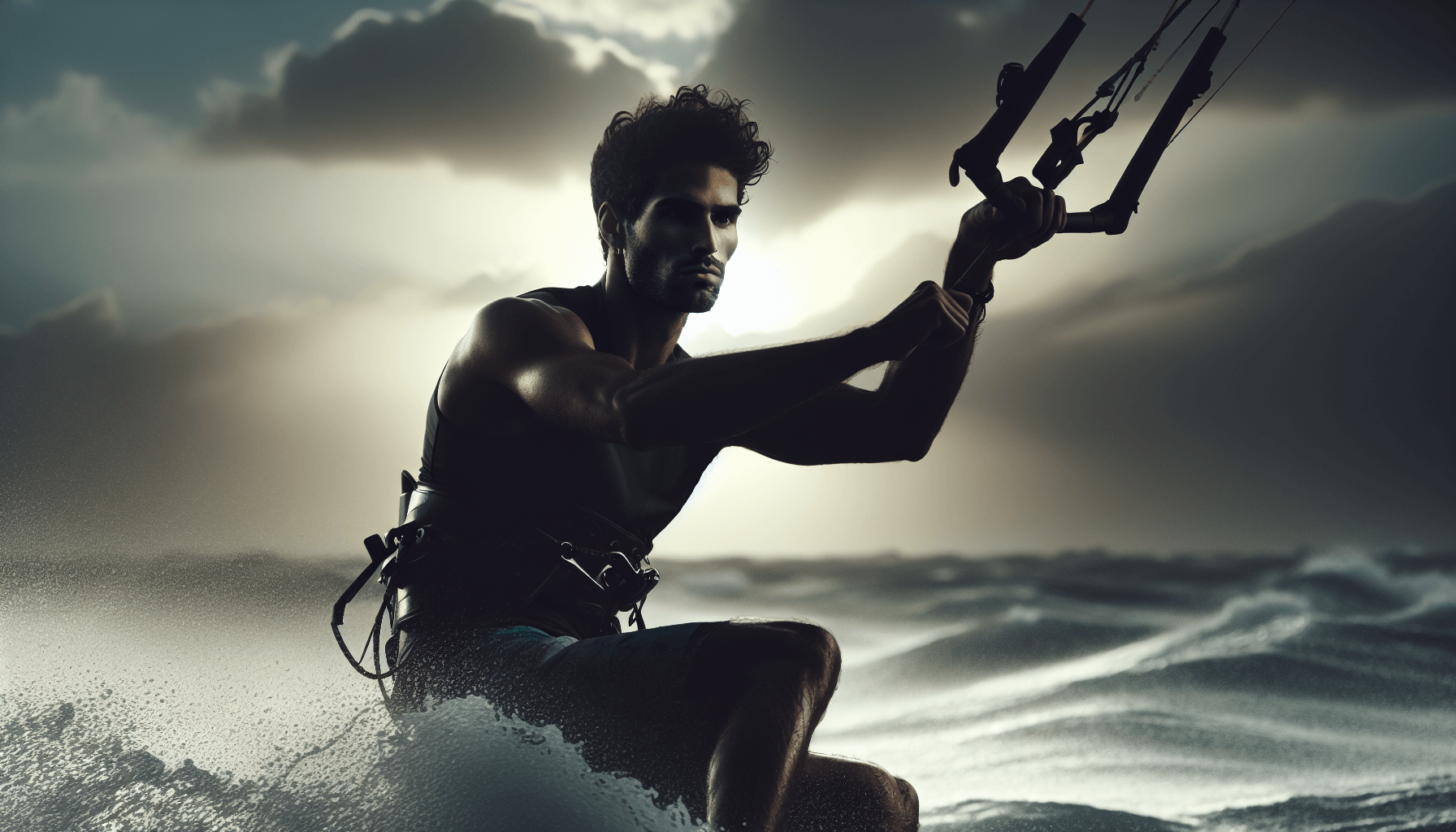
Psychological factors significantly influence kiteboarding protection. Overconfidence among kiteboarders can lead to severe accidents, as feeling more protected or experienced may result in decreased caution and increased risk-taking.
The adrenaline rush and thrill of kitesurfing can prompt riders to engage in higher-risk maneuvers, contributing to dangerous situations. Some vital psychological factors to consider for kitesurfing security are:
- Avoid overconfidence and maintain a healthy level of caution
- Be aware of the adrenaline rush and its potential impact on decision-making
- Practice risk management and avoid engaging in high-risk maneuvers
- Stay focused and alert while kitesurfing to minimize the chances of accidents.
Overcoming Fear and Maintaining Respect for the Sport
In kitesurfing, fear and anxiety can serve as protective mechanisms. However, if not properly managed, they can limit performance. Techniques such as deep breathing, visualization, and positive self-talk can help reduce anxiety and fear in kiteboarding, leading to better performance.
The Dangers of Complacency in Experienced Riders
The complacency of inexperienced riders can cause accidents. Experienced kiteboarders tend to perceive risk as lower than beginners, which can lead to complacency and potential accidents.
Emotional responses, such as a sense of thrill or challenge, may influence experienced riders to underestimate risks and engage in more daring actions.
Experienced riders should use common sense to predict potential underwater hazards and take precautions to avoid them, ensuring their security on the water and practicing safe sport.
Preparing for the Unexpected: Emergency Protocols and Rescue Plans
Preparing for emergencies and having rescue plans is of utmost importance in kiteboarding. To initiate a self-rescue, a kiteboarder should deploy the kite bar’s quick-release system, allowing the kite to flag out and drop and then pull itself to the bar using the safeness line.
Kiteboarders must practice self-rescue techniques like shallow water and packing to competently regain control in unpredictable situations, including gear breakdown or mishaps on the water.
In onshore wind conditions, kiteboarders can transform their kite into a makeshift sail to navigate back to shore by positioning themselves on the leading edge and utilizing the self-rescue handle or bridle.
For offshore winds and waves where making it back to shore by sailing is not feasible, stay safe; kiteboarders should stay afloat within their kite until help arrives or deflate and pack down their kite only if reaching the shore is achievable, or rescue is assured.
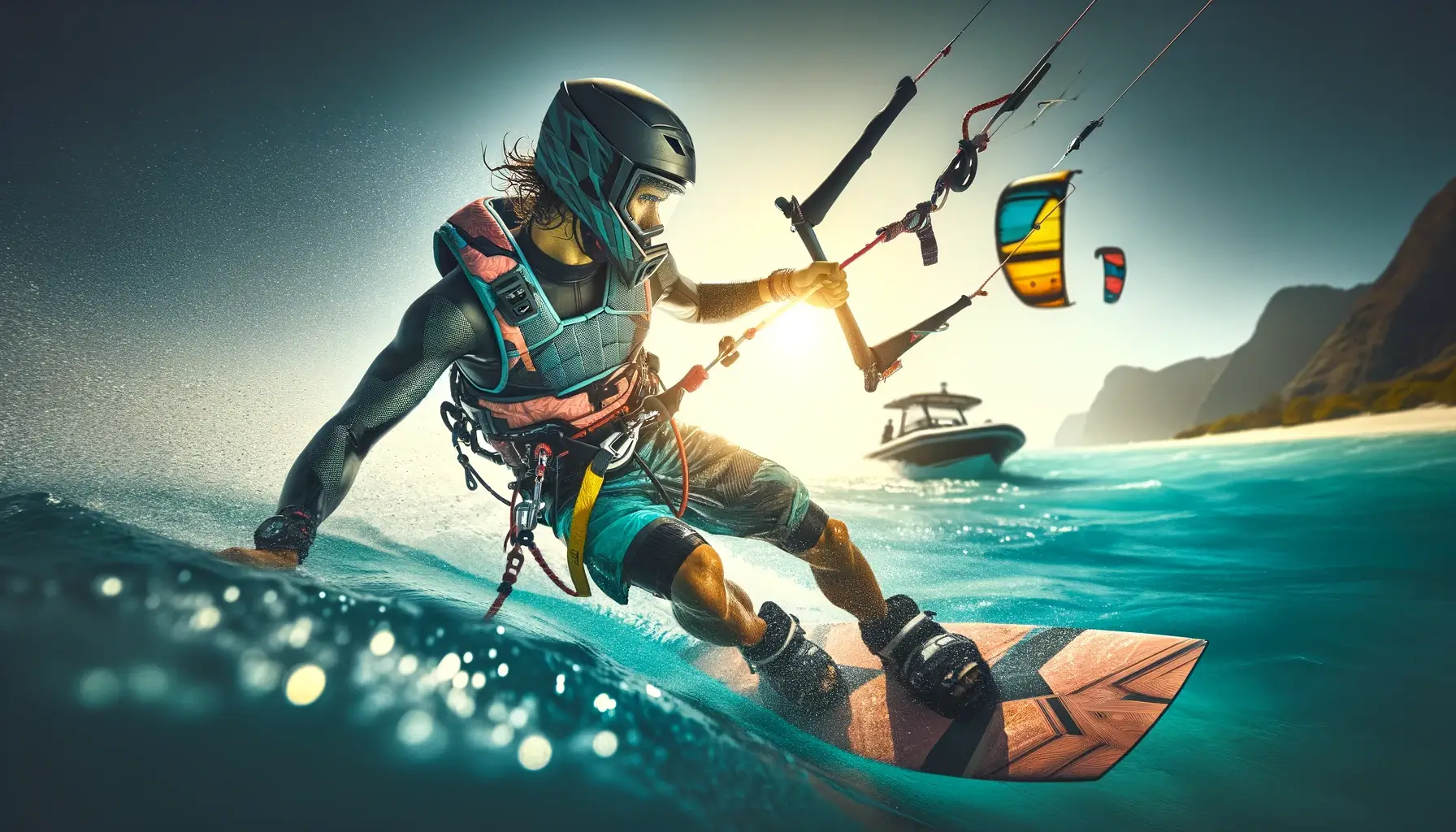
Summary
In conclusion, while kiteboarding carries its share of risks, it can be a safe sport with proper precautions and understanding of gear, wind conditions, and experience level. Understanding the risks, adopting safety measures, appreciating the role of experience, and staying prepared for emergencies are all crucial aspects of ensuring protection in kitesurfing.
As with any sport, the key is to maintain respect for the sport, manage emotions, and stay informed, aware, and prepared.
Frequently Asked Questions
What are the dangers of kiteboarding?
Kiteboarding poses dangers, such as being lofted by strong winds, which can lead to severe accidents and even fatalities if not correctly managed. Assessing wind conditions and using the right kite size is crucial to avoid being overpowered and getting lofted into hazardous situations.
What is the injury rate for kitesurfing?
The injury rate for kitesurfing is estimated to be 7.0 injuries per 1000 hours during practice and 16.6 injuries per 1000 hours during competition. Keep this in mind to prioritize security while kitesurfing.
How difficult is it to learn kitesurfing?
Learning kitesurfing is not as difficult as it may seem, especially if you have experience with power from lessons with other kitesurfers or board sports. With a 3-day, 4-hour per day course, most people can gain confidence and start riding.
What are the main risks associated with kiteboarding?
The main risks in kitesurfing include gear failures, adverse wind and weather conditions, and the potential for common injuries such as cuts, bruises, broken bones, and spinal cord injuries. Awareness of these risks and taking safety precautions when kiting out is essential.
How does experience affect kitesurfing safety?
Experience significantly affects kitesurfing security by enabling kiteboarders to understand better and manage risks, make informed decisions about equipment and weather conditions, and maintain safer riding etiquette.




